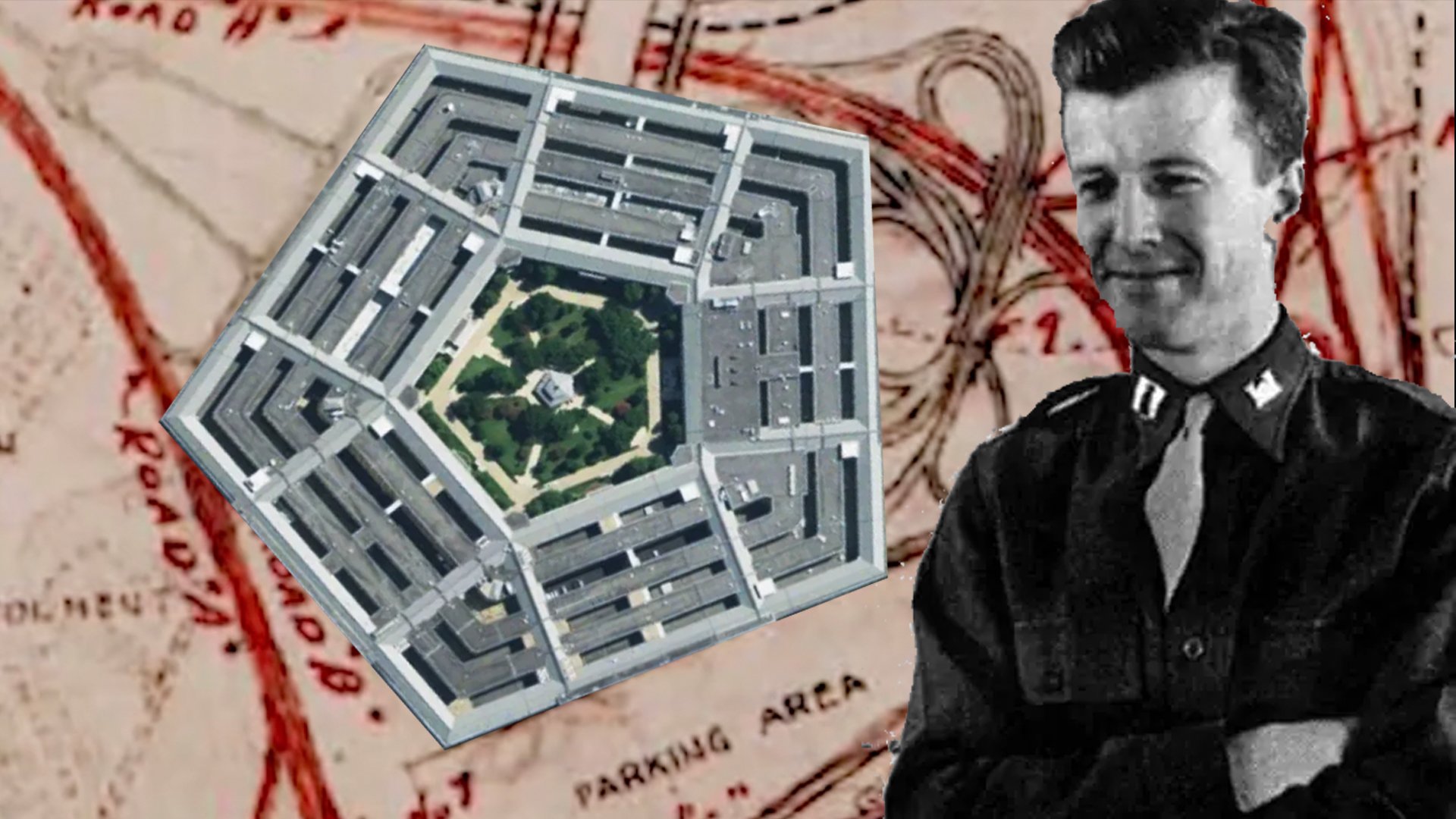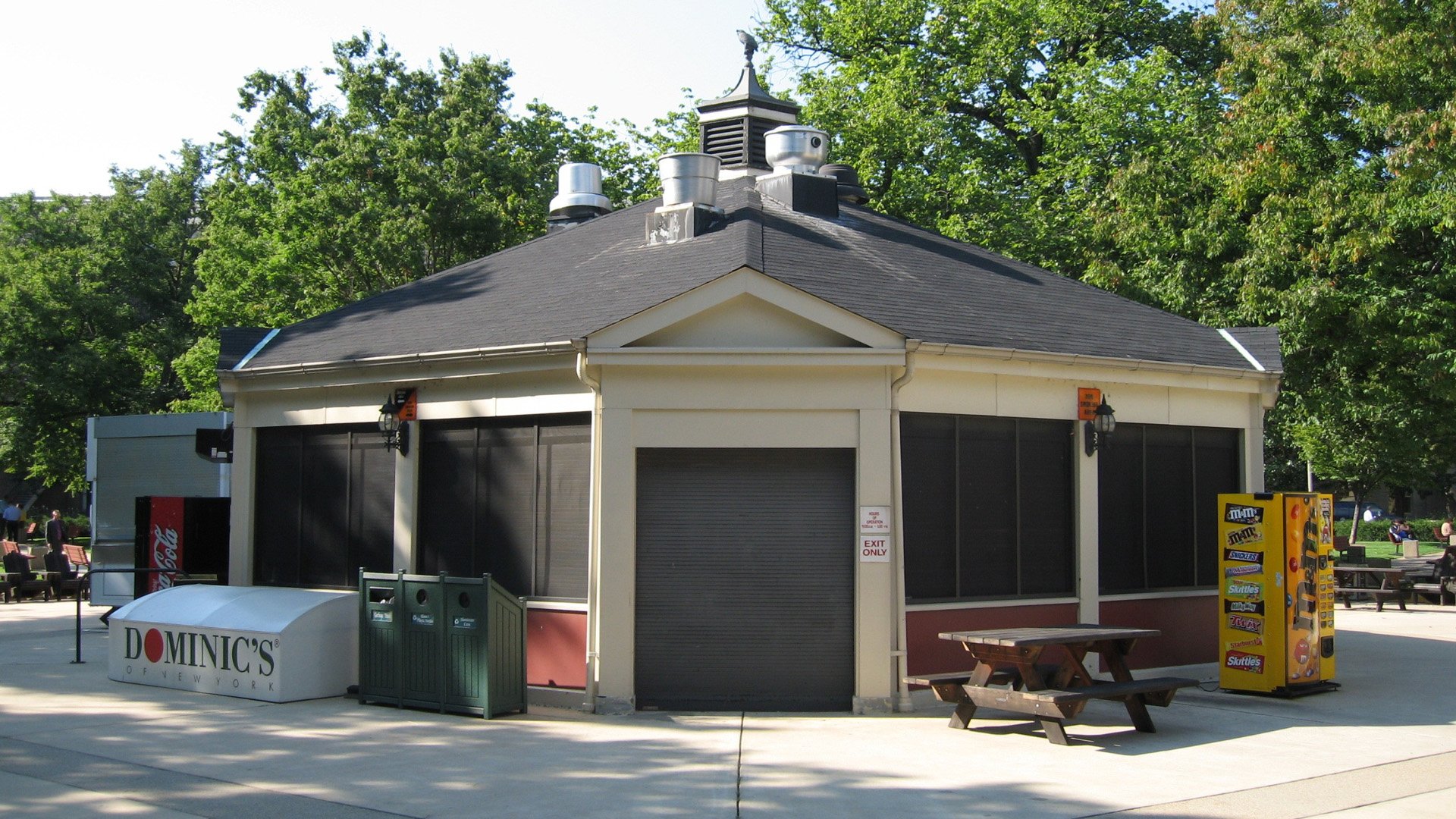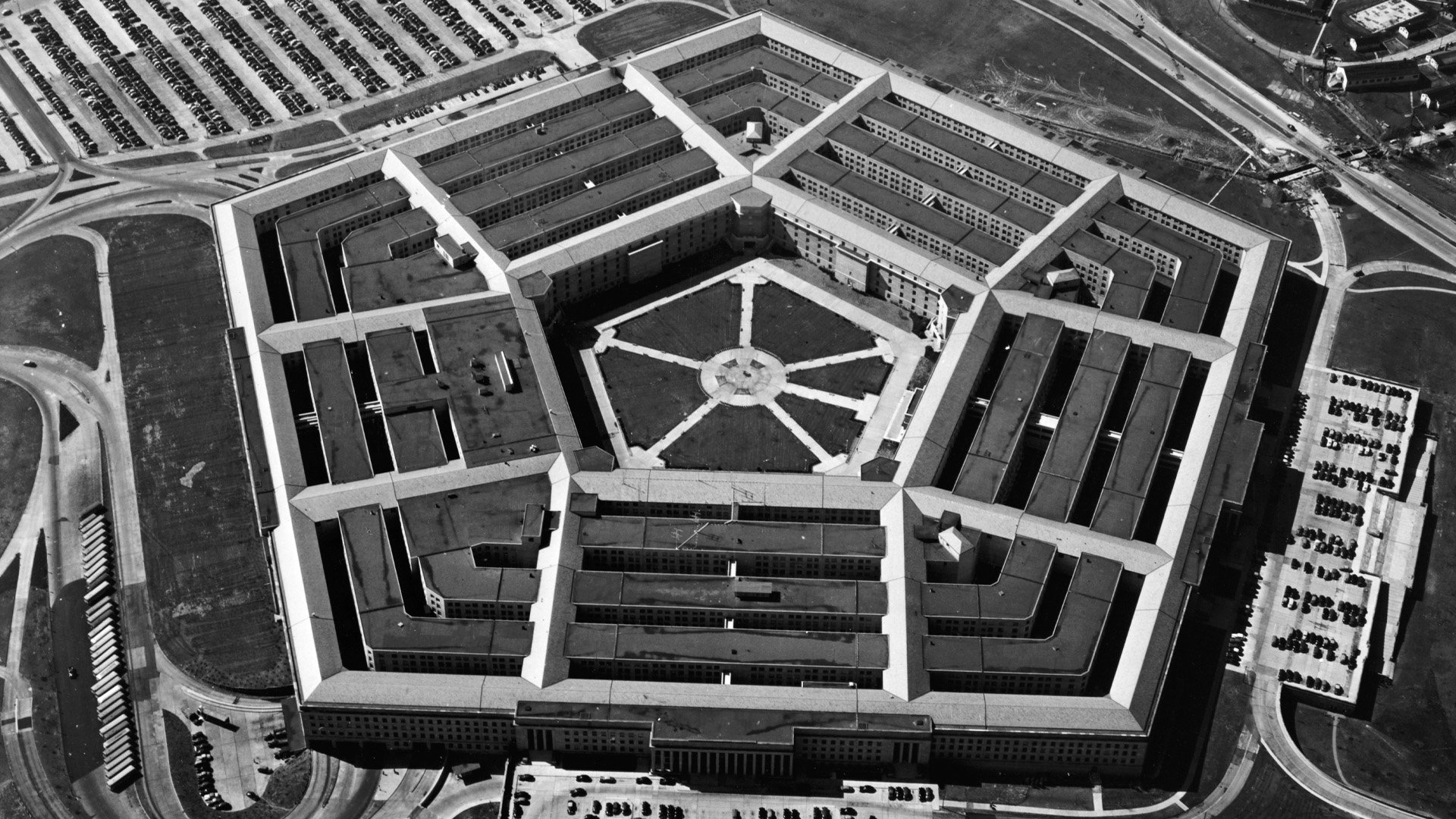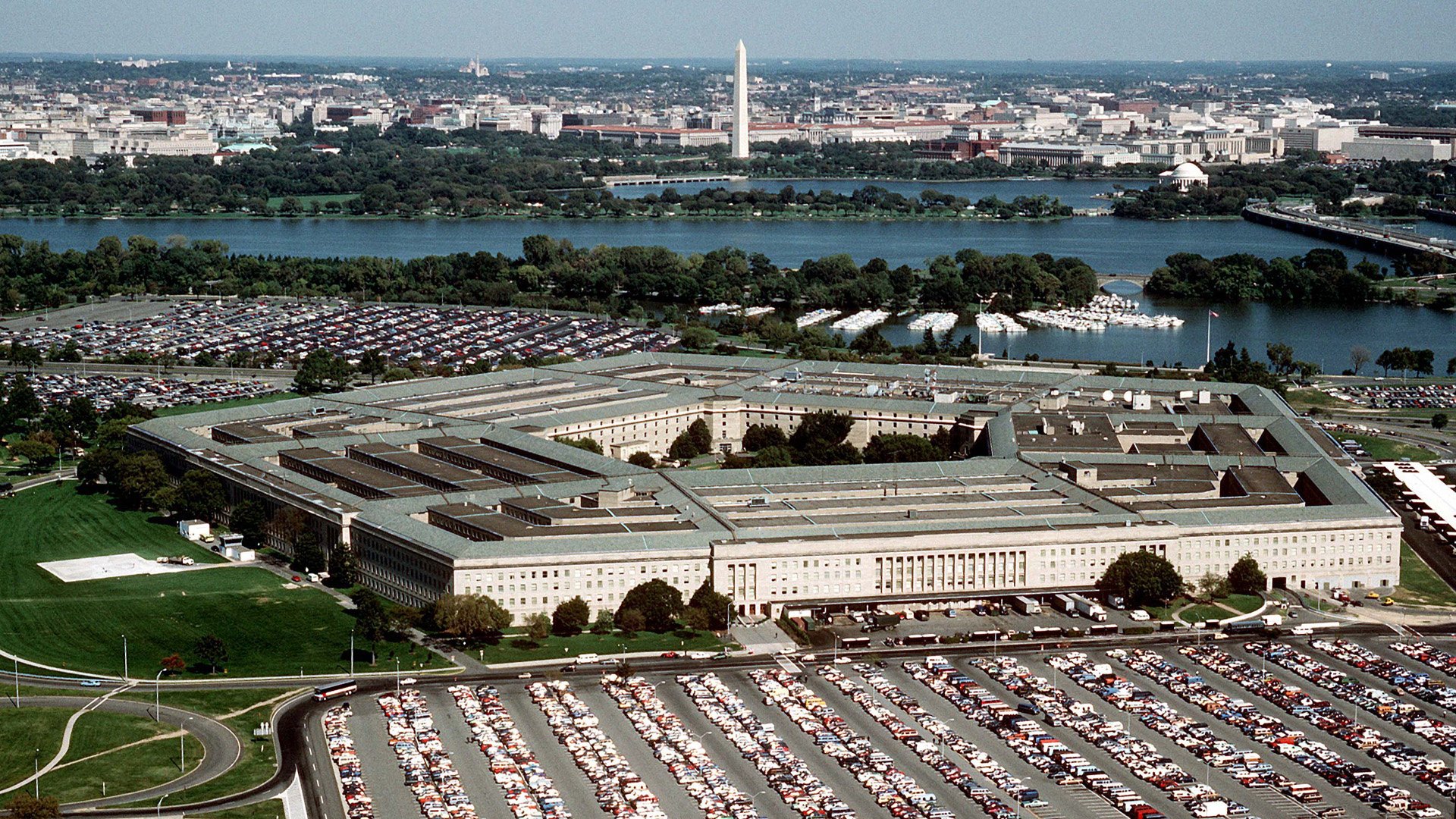A Mystery Bunker, Secret Rooms, and a Ghost: Myths of the Pentagon

Robert Furman, an officer in the Army Corps of Engineers, would become known as the “ghost” of the Pentagon. He had workers build him a secret apartment within its walls during its construction, allowing him to disappear for hours at a time and reappear in the middle of the night. DOD photos. Composite by Matt White/Coffee or Die.
Among the strangest stories about the Pentagon comes one from the chilly early days of the Cold War, when the Soviet Union and the United States had just begun to spy relentlessly on each other with satellites.
According to the legend, in the Pentagon’s center courtyard, crowds of military and civilian officials would gather at the same time every day around a small building. Watching from space, Russian intelligence believed the building was an entrance to an underground bunker or a secret briefing room.
In reality, the crowds came and went on lunch breaks because the building was a popular hot dog stand.
“Rumor has it that during the Cold War, the Russians never had any less than two missiles aimed at this hot dog stand,” said Brett Eaton, a Pentagon information and communications officer. “They thought this was the Pentagon’s most top secret meeting room, and the entire Pentagon was a large fortress built around this hot dog stand.”
Related: How Philippine Food Scientist Maria Orosa Saved Thousands of POWs During World War II

The hot dog stand in the Pentagon’s center courtyard was long a source of Cold War speculation, folklore, and legend. During the Cold War, the Soviets reportedly thought the hot dog stand led to a secret underground bunker. Photo by the Department of Defense.
Under the assumption that Soviet missiles bristling with nuclear warheads were aimed at the stand, it earned the nickname “Cafe Ground Zero.”
But the Pentagon, which has served as the headquarters for the Department of Defense since it was opened in 1943, has more secrets and history behind it than just a popular lunch spot. Here’s everything you need to know about the Pentagon.
It Was Almost the World’s Biggest Hospital
In 1941, Army Brig. Gen. Brehon B. Somervell, head of the Construction Division of the Quartermaster Corps, began formulating plans to create a new headquarters for what was then the War Department. The attacks on Pearl Harbor had not yet occurred, but assisting the Allies in Europe had become a real possibility. Initially, the Pentagon was supposed to be a temporary home, with plans on eventually transforming the space into either a hospital, an office, or a warehouse. But as World War II arrived and then the Cold War, the building was named the permanent home of the Office of the Secretary of Defense and the chiefs of staff of the Army, Navy, Marine Corps, and Air Force.
Related: Who Earns the Armed Forces Service Medal?
Why the Shape of a Pentagon?

The Pentagon pictured in 1947. Photo by the Department of Defense.
It’s not as complicated as one would think. Arlington Farms in Virginia was designated as the initial site for construction. The plot of land connected to five roadways, so the building was designed with five sides, one for each approach. However, President Franklin D. Roosevelt feared the massive structure would obscure the view of Washington, DC, from Arlington National Cemetery and decided it should instead be built farther south at the former site of Washington-Hoover Airport.
Related: Marine Corps Whistleblower Smedley Butler Foils ‘The Business Plot’ Against the White House
The Pentagon Is the Largest Office Building in the World
Construction took only 16 months. The enormous undertaking included about 1,000 architects and 14,000 tradesmen. The team worked around the clock in three shifts. To conserve precious war materials like steel, construction crews devised creative ways to reinforce the concrete structure. For example, workers used approximately 689,000 tons of sand and gravel from the nearby Potomac River.

A view of the Pentagon with the Potomac River and Washington Monument in the background, circa 1998. Wikimedia Commons photo.
The final budget tallied $63 million, or more than $900 million in today’s dollars. On an expedited schedule, the building was finished in January 1943. At the height of World War II, more than 33,000 civilians and military personnel worked there.
The structure is famously five ringed corridors, each five stories tall with two basement levels. Remarkably, there was originally just one elevator. Those who couldn’t take stairs accessed special ramps from floor to floor. When World War II ended, plans to scrap the Pentagon were canceled. Many innovations have since been added; a 17-year project to install 70 elevators began in 1994 and finished in 2011.
The Pentagon claims recognition as the largest office building in the world by floor area. It’s so big that the building has six ZIP codes, 6.5 million square feet of office space (three times the floor space of the Empire State Building), and even a mini shopping mall.
Related: Escaping Colditz Castle: How Allied POWs Broke Free From a Nazi Supermax Prison
There Was a Secret Apartment Above the Pentagon

Then-Capt. Robert Furman stands in front of a plan for the Pentagon circa 1941. Photo courtesy of the Department of Defense.
At the heart of the construction was Col. Leslie Groves, an officer from the Army Corps of Engineers. Groves drove the project hard and required one of his deputies, Maj. Robert Furman, to be at the Pentagon all hours of the day, every day. With nearly no opportunities to go home, Furman pulled some construction contractors aside and had them build him a secret apartment between the walls of what became the Army’s Ordnance Division. It didn’t take long until employees started referring to him as a ghost, disappearing without a trace and reemerging the next day, never leaving the building.
Furman later served as an intelligence officer on the Manhattan Project, the top-secret program to develop nuclear weapons. When he traveled back to Washington for that work, he continued to use the windowless apartment, slipping in and out around employees. Eventually, curious ordnance officers discovered his crash pad, and he was forced out.
The Ghost of the Pentagon, it seems, really was only looking for a place to rest.
Related: How the New York Rangers Honored the FDNY’s ‘Master of Disaster’ After 9/11
Attacked on 9/11

An aerial view of the destruction at the Pentagon caused by a hijacked commercial jet that crashed into the side of the building during the Sept. 11, 2001, terror attacks. Photo by Air Force Tech. Sgt. Cedric H. Rudisill.
On the morning of Sept. 11, 2001, American Airlines Flight 77 was hijacked by terrorists who crashed the plane into the west side of the Pentagon. The impact penetrated three of the Pentagon's five corridor rings, killing 189 people in the plane and building, including the five hijackers. But there was a stroke of luck: The attack’s impact zone hit an area undergoing construction. New sprinkler systems, increased structural support, and blast-resistant windows helped limit the amount of destruction. More importantly, only 800 of about 4,500 people typically occupying the section were present.
Three days after the attacks, the Pentagon awarded contracts to rebuild the damaged areas of the building. This repair and renovation endeavor became known as the Phoenix Project and ultimately cost more than $5 billion.
The Cold War-era hot dog stand, long since replaced by a food court, was wrecked by jet fuel, smoke, and water.
A modern replacement court opened just six months later, followed by two more and a supermarket.
The Phoenix Project was completed in February 2003 as the Pentagon shifted focus from hunting al Qaeda in Afghanistan to war in Iraq.
Read Next: An FBI Special Agent’s Unforgettable Journey to the Pentagon on 9/11

Matt Fratus is a history staff writer for Coffee or Die. He prides himself on uncovering the most fascinating tales of history by sharing them through any means of engaging storytelling. He writes for his micro-blog @LateNightHistory on Instagram, where he shares the story behind the image. He is also the host of the Late Night History podcast. When not writing about history, Matt enjoys volunteering for One More Wave and rooting for Boston sports teams.
BRCC and Bad Moon Print Press team up for an exclusive, limited-edition T-shirt design!
BRCC partners with Team Room Design for an exclusive T-shirt release!
Thirty Seconds Out has partnered with BRCC for an exclusive shirt design invoking the God of Winter.
Lucas O'Hara of Grizzly Forge has teamed up with BRCC for a badass, exclusive Shirt Club T-shirt design featuring his most popular knife and tiomahawk.
Coffee or Die sits down with one of the graphic designers behind Black Rifle Coffee's signature look and vibe.
Biden will award the Medal of Honor to a Vietnam War Army helicopter pilot who risked his life to save a reconnaissance team from almost certain death.
Ever wonder how much Jack Mandaville would f*ck sh*t up if he went back in time? The American Revolution didn't even see him coming.
A nearly 200-year-old West Point time capsule that at first appeared to yield little more than dust contains hidden treasure, the US Military Academy said.












